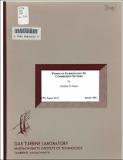Feedback stabilization of compression systems
Author(s)
Simon, Jonathan S. (Jonathan Seth)
Download28274484.pdf (9.537Mb)
Other Contributors
Massachusetts Institute of Technology. Gas Turbine Laboratory
Metadata
Show full item recordAbstract
An experimental and analytical study was conducted on the use of feedback stabilization to extend the stable operating range of compression and pumping systems. Prevention of surge, in aircraft gas turbine engines, an instability characterized by violent system wide oscillations in pressure, and flow, primarily motivated this research. However, such instabilities arise as a result of the non-monotonic pressure/flow relations of the axial and/or centrifugal compressors used in gas turbine engines and the results of this research can therefore be applied to many other compression and pumping systems which also employ these types of devices. The frequency response of a centrifugal compressor was measured to validate a lumped parameter model of this component. The results showed that the model is useful for control design and analysis purposes. Modeling the flow development process as a first order lag was shown to account for observed phenomena that were not predicted by a quasi-steady model. Theoretical limitations to the control of this class of systems that are imposed by bounded actuation and stability robustness requirements were characterized and quantified. The limitations are shown to depend strongly on the choice of actuator and sensor. The influence of actuator/sensor selection was further defined by systematically evaluating a diverse range of available options. The practical difficulty, as well as the number of viable options, were found to depend primarily on the slope of the compressor pressure rise characteristic and the system B-parameter, which represents the relative amount of fluid compliance to inertia. An important result is that only options which can be considered dynamically close-coupled to the compressor are viable for systems with B-parameter and non-dimensional slope substantially greater than unity. One particular close-coupled scheme, a control valve at the compressor exit with compressor mass flow feedback, was examined in detail and experimentally demonstrated. Although the system of interest can also be stabilized with a passive flow restriction, it is shown that the use of feedback control reduces the steady state pressure loss across the valve required for stabilization. The benefits are greatest for systems with relatively steep slopes at high flow.
Description
Includes bibliographical references (pages 244-250)
Date issued
1993Publisher
Cambridge, Mass. : Gas Turbine Laboratory, Massachusetts Institute of Technology, 1993
Series/Report no.
GTL report #216